HONDA ACCORD HYBRID 2007 CL7 / 7.G Owner's Manual
Manufacturer: HONDA, Model Year: 2007, Model line: ACCORD HYBRID, Model: HONDA ACCORD HYBRID 2007 CL7 / 7.GPages: 287, PDF Size: 5.38 MB
Page 21 of 287
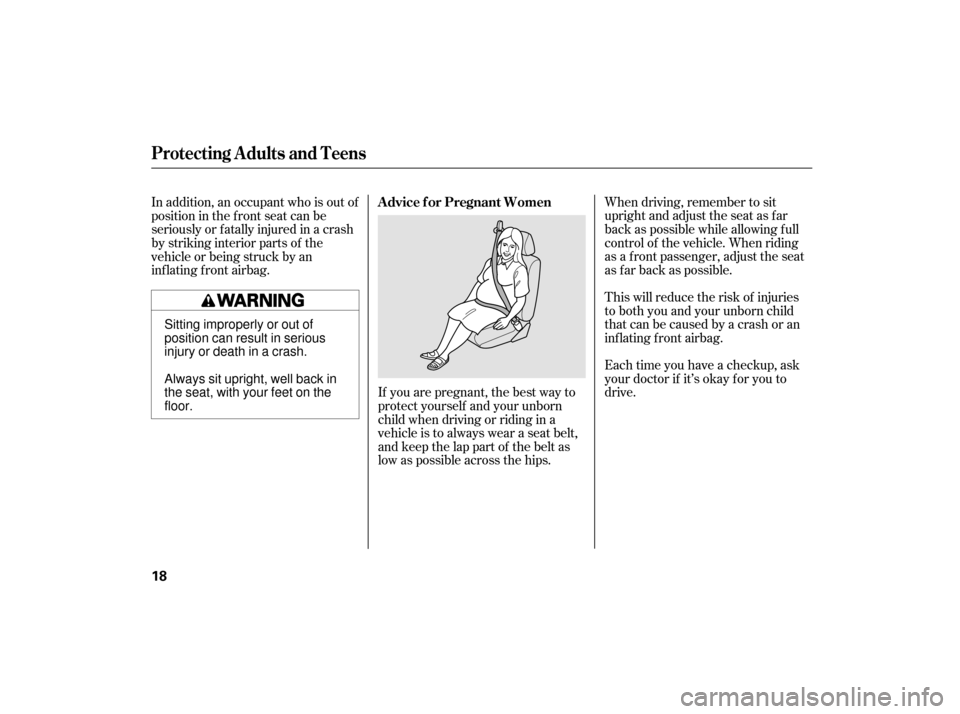
When driving, remember to sit
upright and adjust the seat as f ar
back as possible while allowing f ull
control of the vehicle. When riding
as a f ront passenger, adjust the seat
as far back as possible.
This will reduce the risk of injuries
to both you and your unborn child
that can be caused by a crash or an
inflating front airbag.
Each time you have a checkup, ask
your doctor if it’s okay f or you to
drive.
If you are pregnant, the best way to
protect yourself and your unborn
child when driving or riding in a
vehicle is to always wear a seat belt,
and keep the lap part of the belt as
low as possible across the hips.
In addition, an occupant who is out of
position in the f ront seat can be
seriously or f atally injured in a crash
by striking interior parts of the
vehicle or being struck by an
inflating front airbag.
Protecting A dults and Teens
Advice f or Pregnant Women
18
Sitting improperly or out of
position can result in serious
injury or death in a crash.
Always sit upright, well back in
the seat, with your feet on the
floor.
06/08/08 14:17:56 31SDR620_023
Page 22 of 287

If your
hands or arms are close to an
airbag cover, they could be injured
if the airbag inf lates.
Objects on
the covers marked ‘‘SRS AIRBAG’’
could interf ere with the proper
operation of the airbags or be
propelled inside the vehicle and
hurt someone if the airbags inf late.
If they do, they
could be very seriously injured in a
crash.
Carrying hard or sharp
objects on your lap, or driving with
a pipe or other sharp object in
your mouth, can result in injuries
if your f ront airbag inf lates. Devices intended to improve
occupant comf ort or reposition the
shoulder part of a seat belt can
reduce the protective capability of
thebeltandincreasethechanceof
serious injury in a crash.
If a side airbag or a
side curtain airbag inf lates, a cup
holder or other hard object
attached on or near the door could
be propelled inside the vehicle and
hurt someone.
Protecting A dults and Teens
K eep your hands and arms away
f rom t he airbag covers.
Do not at t ach or place object s onthe f ront airbag covers.
T wo people should never use t he
same seat belt .
Do not place hard or sharp object sbet ween yourself and a f rontairbag.
Do not put any accessories on seat
belts.
Do not at t ach hard object s on ornear a door.Additional Saf ety Precautions
Driver and Passenger Saf ety
19
06/08/08 14:18:04 31SDR620_024
Page 23 of 287

Your seat belt system includes lap/
shoulder belts in all f ive seating
positions. The f ront seat belts are
also equipped with automatic seat
belt tensioners.This system monitors the f ront seat
belts. If you turn the ignition switch
to the ON (II) position bef ore your
seat belt is f astened, the beeper will
sound and the indicator will f lash. If
your seat belt is not f astened bef ore
the beeper stops, the indicator will
stop f lashing but remain on.
This system uses the same sensors
as the front airbags to monitor
whether the f ront seat belts are
latched or unlatched, and how much
weight is on the f ront passenger’s
seat (see pages and ).
The seat belt system
includes an indicator on the
instrument panel and a beeper to
remind you and your passengers to
f asten your seat belts. If a f ront passenger does not f asten
their seat belt, the indicator will
come on about 6 seconds af ter the
ignition switch is turned to the ON
(II) position.
If either the driver or a f ront
passenger does not f asten their seat
belt while driving, the beeper will
sound and the indicator will f lash
again at regular intervals.
When no one is sitting in the f ront
passenger’s seat, or a child or small
adult is riding there, the indicator
should not come on and the beeper
should not sound.
28 29
Additional Inf ormation About Your Seat Belts
Seat Belt System Components
20
06/08/08 14:18:12 31SDR620_025
Page 24 of 287

All seat belts have an emergency
locking retractor. In normal driving,
the retractor lets you move f reely in
your seat while it keeps some
tension on the belt. During a collision
or sudden stop, the retractor
automatically locks the belt to help
restrain your body.
The lap and shoulder belt goes over
your shoulder, across your chest,
and across your hips.
To fasten the belt, insert the latch
plate into the buckle, then tug on the
belt to make sure the buckle is
latched (see page f or how to
properly position the belt).
To unlock the belt, press the red
PRESSbuttononthebuckle.Guide
the belt across your body so that it
retracts completely. Af ter exiting the
vehicle, be sure the belt is out of the
way and will not get closed in the
door.
Any items under the f ront
passenger’s seat.
Any objects hanging on the seat or
in the seat-back pocket.
If the indicator comes on or the
beeper sounds when the driver’s seat
belt is latched and there is no f ront
seat passenger and no items on the
front seat, something may be
interf ering with the monitoring
system. Look f or and remove:
If no obstructions are f ound, have
your vehicle checked by a dealer.
Any object touching the rear of
the seat-back. 16
CONT INUED
L ap/Shoulder Belt
Additional Inf ormation About Your Seat Belts
Driver and Passenger Saf ety
21
06/08/08 14:18:22 31SDR620_026
Page 25 of 287
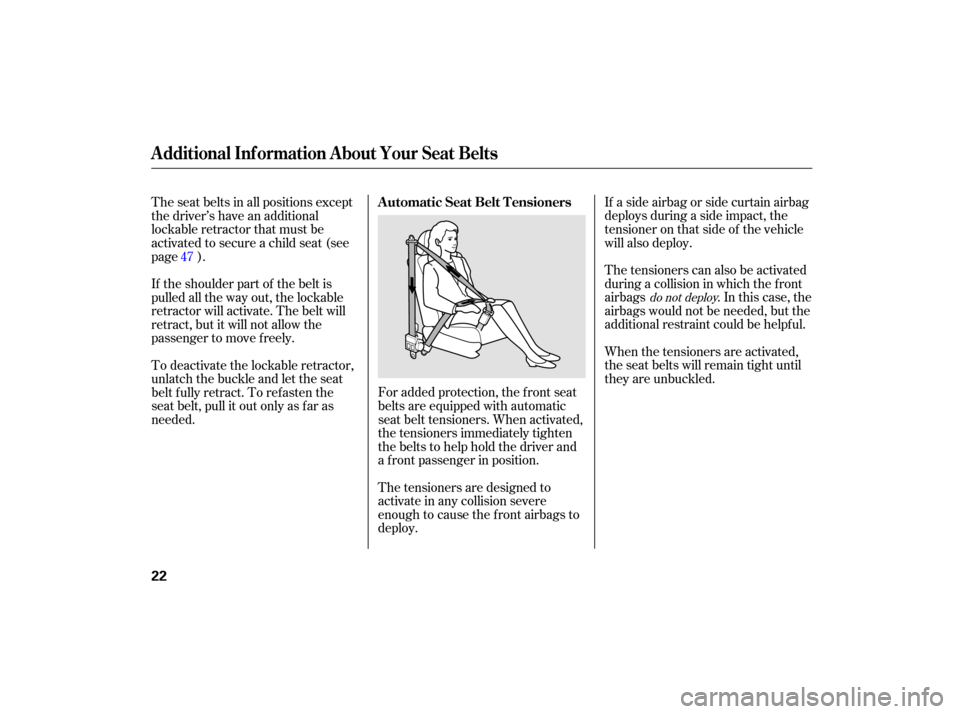
If a side airbag or side curtain airbag
deploys during a side impact, the
tensioner on that side of the vehicle
will also deploy.
The tensioners can also be activated
during a collision in which the f ront
airbags . In this case, the
airbags would not be needed, but the
additional restraint could be helpf ul.
When the tensioners are activated,
the seat belts will remain tight until
they are unbuckled.
The tensioners are designed to
activate in any collision severe
enough to cause the f ront airbags to
deploy. For added protection, the f ront seat
belts are equipped with automatic
seat belt tensioners. When activated,
the tensioners immediately tighten
the belts to help hold the driver and
a f ront passenger in position.
The seat belts in all positions except
the driver’s have an additional
lockable retractor that must be
activated to secure a child seat (see
page ).
If the shoulder part of the belt is
pulled all the way out, the lockable
retractor will activate. The belt will
retract, but it will not allow the
passenger to move f reely.
To deactivate the lockable retractor,
unlatch the buckle and let the seat
belt fully retract. To refasten the
seat belt, pull it out only as f ar as
needed.
47
do not deploy
Additional Inf ormation About Your Seat Belts
A utomatic Seat Belt T ensioners
22
06/08/08 14:18:33 31SDR620_027
Page 26 of 287

If a seat belt is worn during a crash,
it must be replaced by your dealer. A
belt that has been worn during a
crash may not provide the same level
of protection in a subsequent crash.
The dealer should also inspect the
anchors f or damage and replace
them if needed. If the automatic seat
belt tensioners activate during a
crash, they must be replaced.
For saf ety, you should check the
condition of your seat belts regularly.
Pull each belt out f ully, and look f or
f rays, cuts, burns, and wear. Check
that the latches work smoothly and
the belts retract easily. If a belt does
not retract easily, cleaning the belt
may correct the problem (see page
). Any belt that is not in good
condition or working properly will
not provide good protection and
should be replaced as soon as
possible.
Honda provides a limited warranty
on seat belts. See your booklet f or
details. 219
Honda
Warranty Inf ormation
Additional Inf ormation About Your Seat Belts
Seat Belt Maintenance
Driver and Passenger Saf ety
23
Not checking or maintaining
seat belts can result in serious
injury or death if the seat belts
do not work properly when
needed.
Check your seat belts regularly
and have any problem
corrected as soon as possible.
06/08/08 14:18:42 31SDR620_028
Page 27 of 287
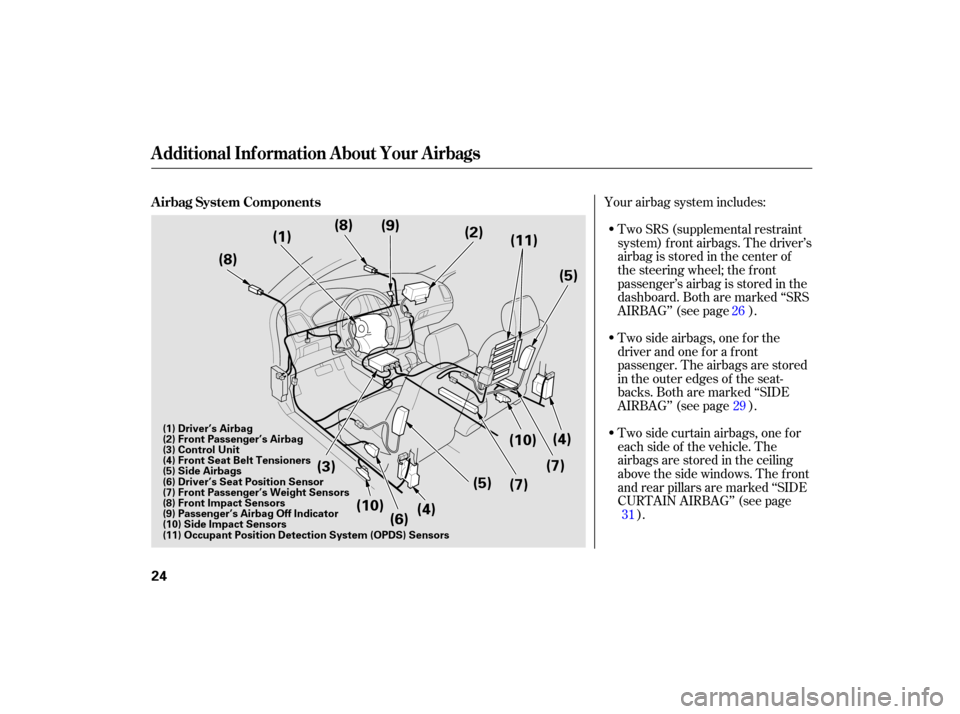
Your airbag system includes:Two SRS (supplemental restraint
system) f ront airbags. The driver’s
airbag is stored in the center of
the steering wheel; the f ront
passenger’sairbagisstoredinthe
dashboard. Both are marked ‘‘SRS
AIRBAG’’ (see page ).
Two side airbags, one f or the
driver and one f or a f ront
passenger. The airbags are stored
in the outer edges of the seat-
backs. Both are marked ‘‘SIDE
AIRBAG’’ (see page ).
Two side curtain airbags, one f or
each side of the vehicle. The
airbags are stored in the ceiling
above the side windows. The front
and rear pillars are marked ‘‘SIDE
CURTAIN AIRBAG’’ (see page ). 26
29
31
A irbag System Components
Additional Inf ormation About Your Airbags
24
(1)
(2)
(3) (4)(5)
(8)
(7)
(10) (11)
(9)
(6) (4)
(7)
(8)
(5)
(10)
(11) Occupant Position Detection System (OPDS) Sensors (1) Driver’s Airbag
(2) Front Passenger’s Airbag
(3) Control Unit
(4) Front Seat Belt Tensioners
(5) Side Airbags
(6) Driver’s Seat Position Sensor
(7) Front Passenger’s Weight Sensors
(8) Front Impact Sensors
(9) Passenger’s Airbag Off Indicator
(10) Side Impact Sensors
06/08/08 14:18:52 31SDR620_029
Page 28 of 287
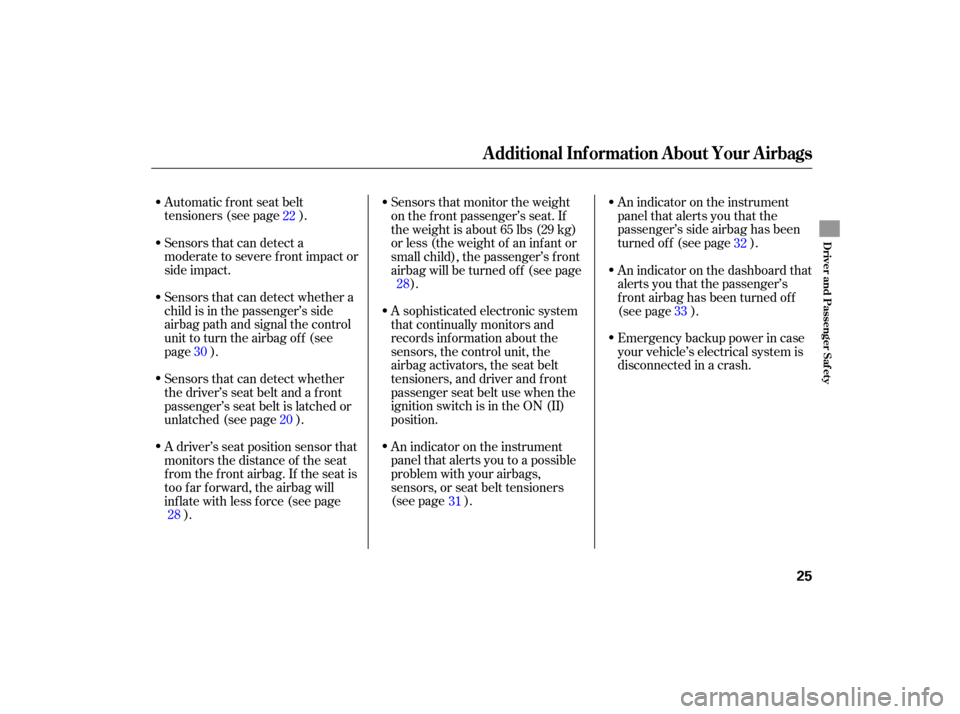
Automatic front seat belt
tensioners (see page ).
Sensors that can detect a
moderate to severe front impact or
side impact.
An indicator on the instrument
panel that alerts you that the
passenger’s side airbag has been
turned of f (see page ).
Emergency backup power in case
your vehicle’s electrical system is
disconnected in a crash.
Sensors that can detect whether a
child is in the passenger’s side
airbag path and signal the control
unit to turn the airbag of f (see
page ).
An indicator on the instrument
panel that alerts you to a possible
problem with your airbags,
sensors, or seat belt tensioners
(see page ).
A sophisticated electronic system
that continually monitors and
records inf ormation about the
sensors, the control unit, the
airbag activators, the seat belt
tensioners, and driver and f ront
passenger seat belt use when the
ignition switch is in the ON (II)
position.
Sensors that monitor the weight
on the f ront passenger’s seat. If
the weight is about 65 lbs (29 kg)
or less (the weight of an inf ant or
small child), the passenger’s f ront
airbag will be turned off (see page
).
A driver’s seat position sensor that
monitors the distance of the seat
from the front airbag. If the seat is
too f ar f orward, the airbag will
inf late with less f orce (see page
).
Sensors that can detect whether
the driver’s seat belt and a f ront
passenger’s seat belt is latched or
unlatched (see page ).
An indicator on the dashboard that
alerts you that the passenger’s
f ront airbag has been turned of f
(see page ).
20
22
28
28
31
33
32
30
Additional Inf ormation About Your Airbags
Driver and Passenger Saf ety
25
06/08/08 14:19:03 31SDR620_030
Page 29 of 287
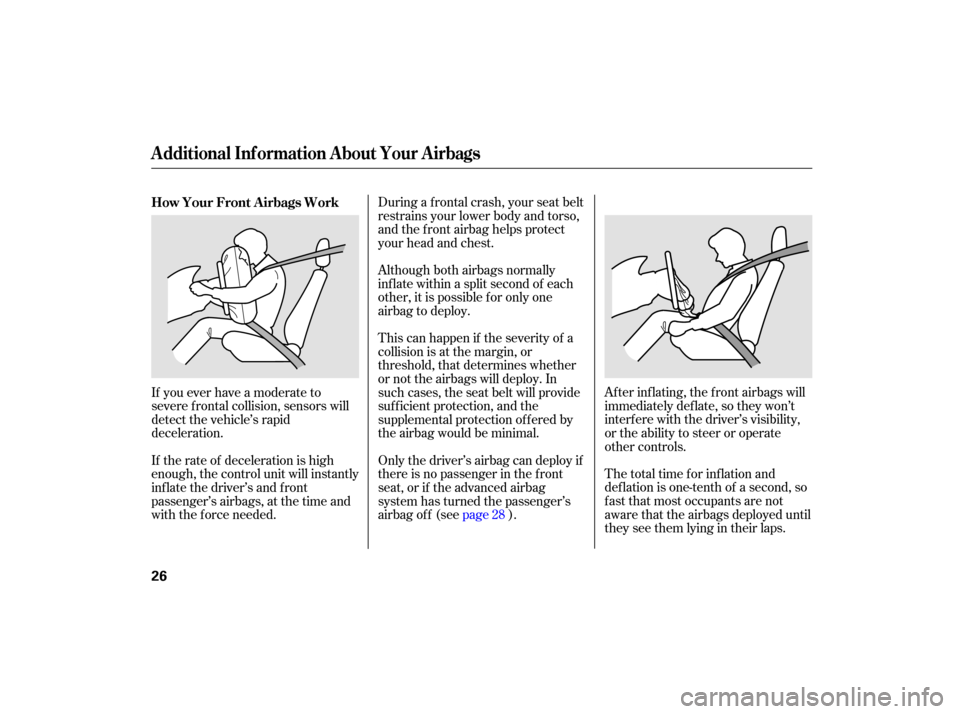
Af ter inf lating, the f ront airbags will
immediately def late, so they won’t
interf ere with the driver’s visibility,
or the ability to steer or operate
other controls.
The total time for inflation and
def lation is one-tenth of a second, so
f ast that most occupants are not
aware that the airbags deployed until
they see them lying in their laps.
During a f rontal crash, your seat belt
restrains your lower body and torso,
and the f ront airbag helps protect
your head and chest.
Although both airbags normally
inf late within a split second of each
other, it is possible f or only one
airbag to deploy.
This can happen if the severity of a
collision is at the margin, or
threshold, that determines whether
or not the airbags will deploy. In
such cases, the seat belt will provide
suf f icient protection, and the
supplemental protection of f ered by
the airbag would be minimal.
If you ever have a moderate to
severe f rontal collision, sensors will
detect the vehicle’s rapid
deceleration.
If the rate of deceleration is high
enough, the control unit will instantly
inf late the driver’s and f ront
passenger’s airbags, at the time and
with the f orce needed. Only the driver’s airbag can deploy if
there is no passenger in the f ront
seat, or if the advanced airbag
system has turned the passenger’s
airbag off (seepage).
28
How Your Front Airbags Work
Additional Inf ormation About Your Airbags
26
06/08/08 14:19:13 31SDR620_031
Page 30 of 287

Your f ront airbags are also dual-
threshold airbags. Airbags with this
f eature have two deployment
thresholds that depend on whether
sensors detect the occupant is
wearing a seat belt or not.
If the occupant’s belt is ,
the airbag will deploy at a slightly
lower threshold, because the
occupant would need extra
protection.
Your f ront airbags are dual-stage
airbags. This means they have two
inf lation stages that can be ignited
sequentially or simultaneously,
depending on crash severity.
In a crash, both stages
will ignite simultaneously to provide
the quickest and greatest protection.
In a crash, one stage will
ignite first, then the second stage
will ignite a split second later. This
provides longer airbag inf lation time
with a little less force.
After a crash, you may see what
looks like smoke. This is actually
powder f rom the airbag’s surf ace.
Although the powder is not harmf ul,
people with respiratory problems
mayexperiencesometemporary
discomf ort. If this occurs, get out of
the vehicle as soon as it is saf e to do
so.
If the occupant’s belt is , the
airbag will inf late at a slightly higher
threshold, when the airbag would be
needed to supplement the protection
provided by the seat belt.
CONT INUED
Dual-T hreshold A irbags
not lat ched
Dual-Stage A irbags
more severeless severe latched
Additional Inf ormation About Your Airbags
Driver and Passenger Saf ety
27
06/08/08 14:19:25 31SDR620_032